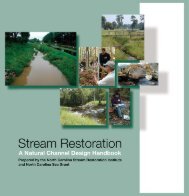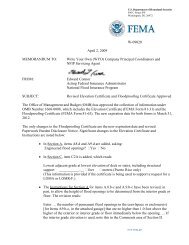Using Multi-Objective Management to Reduce Flood Losses in Your
Using Multi-Objective Management to Reduce Flood Losses in Your
Using Multi-Objective Management to Reduce Flood Losses in Your
Create successful ePaper yourself
Turn your PDF publications into a flip-book with our unique Google optimized e-Paper software.
<strong>Your</strong> written problem<br />
statement may<br />
devote just as much<br />
space <strong>to</strong> each of the<br />
other concerns as it<br />
does <strong>to</strong> flood<strong>in</strong>g. To<br />
be a true multiobjective<br />
approach,<br />
you may have <strong>to</strong><br />
suppress your desire<br />
<strong>to</strong> make flood<strong>in</strong>g the<br />
number-one concern.<br />
Other concerns<br />
A M-O-M plan needs <strong>to</strong> discuss the other objectives besides<br />
protection from natural hazards. Dur<strong>in</strong>g this phase of the<br />
plann<strong>in</strong>g process, you should be <strong>in</strong>volv<strong>in</strong>g representatives of<br />
the other <strong>in</strong>terests discussed <strong>in</strong> Chapter 4. Some of them may<br />
already have written problem statements or plans that they can<br />
give you.<br />
A f<strong>in</strong>al <strong>to</strong>pic that should be addressed is the future.<br />
<strong>Your</strong> problem def<strong>in</strong>ition should review expected changes <strong>to</strong> the<br />
watershed and floodpla<strong>in</strong>, especially the development potential<br />
of vacant land. It should also note the trends for redevelop<strong>in</strong>g<br />
flood-prone areas.<br />
Agree on Goals and <strong>Objective</strong>s<br />
Up <strong>to</strong> now, the plann<strong>in</strong>g work has been relatively noncontroversial. You have<br />
been talk<strong>in</strong>g <strong>to</strong> agencies and organizations and collect<strong>in</strong>g and record<strong>in</strong>g facts. Now<br />
comes the <strong>to</strong>ugh part−gett<strong>in</strong>g people <strong>to</strong> agree on what should be done.<br />
Goals and objectives<br />
Goals are general statements of direction, such as “reduce flood damage <strong>to</strong><br />
exist<strong>in</strong>g build<strong>in</strong>gs” or “improve recreational opportunities.” <strong>Objective</strong>s are more<br />
specific targets. Examples of objectives that support these two goals could be<br />
“acquire and relocate the homes on Small Creek between 1 ST and 3 RD Avenues”<br />
and “double the number of boat slips so more people can use the lake.”<br />
Community goals and objectives and other potentially controversial issues<br />
may already have been resolved if the community has prepared other plans <strong>in</strong> the<br />
past. But it is more likely that you will need <strong>to</strong> identify and clarify everyone’s<br />
concerns and goals so you can all agree on the word<strong>in</strong>g of your statements of the<br />
goals and objectives.<br />
Reach<strong>in</strong>g agreement<br />
It is often fairly easy <strong>to</strong> reach agreement on overall goals, but it is not unusual <strong>to</strong><br />
take a long time <strong>to</strong> reach consensus on specific objectives as they relate <strong>to</strong><br />
particular areas of the community or <strong>in</strong>dividual properties. However, the time<br />
spent is well worth it, because this is vital <strong>to</strong> ga<strong>in</strong><strong>in</strong>g everyone’s agreement and<br />
cooperation.<br />
It helps if goals are positive statements, someth<strong>in</strong>g people can work for,<br />
rather than negative statements about the community’s deficiencies. Where<br />
possible, settle on goals and objectives that support more than one <strong>in</strong>terest, e.g.,<br />
“implement erosion reduction measures <strong>to</strong> susta<strong>in</strong> farmland, improve water<br />
quality, and reduce sedimentation <strong>in</strong> stream channels.”<br />
Generally, “agreement” means consensus or someth<strong>in</strong>g everyone can live<br />
with. You should strive for unanimous support or at least agreement that no one<br />
will oppose a goal or objective. Short of that, you have <strong>to</strong> judge for yourself if<br />
you must settle for a decision by majority vote on a particularly contentious issue.<br />
52















